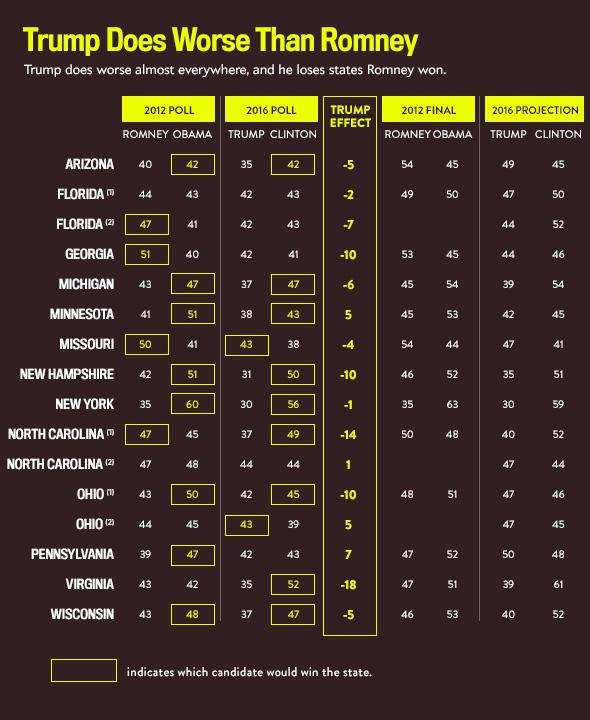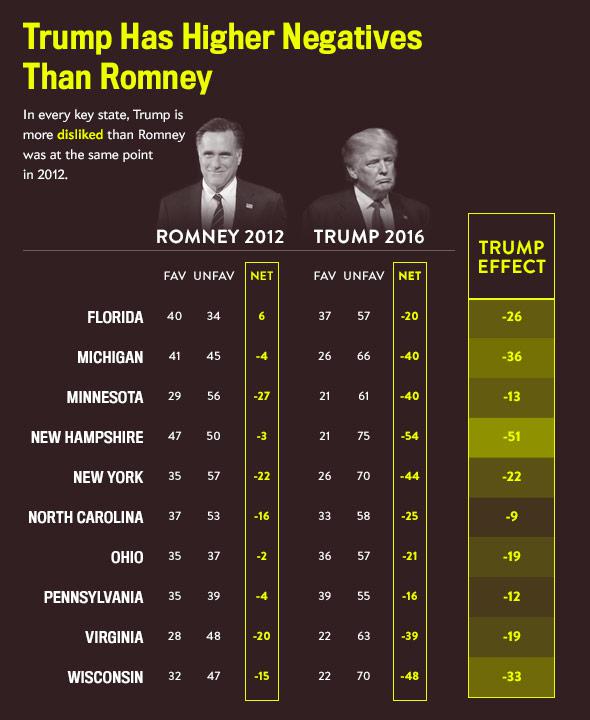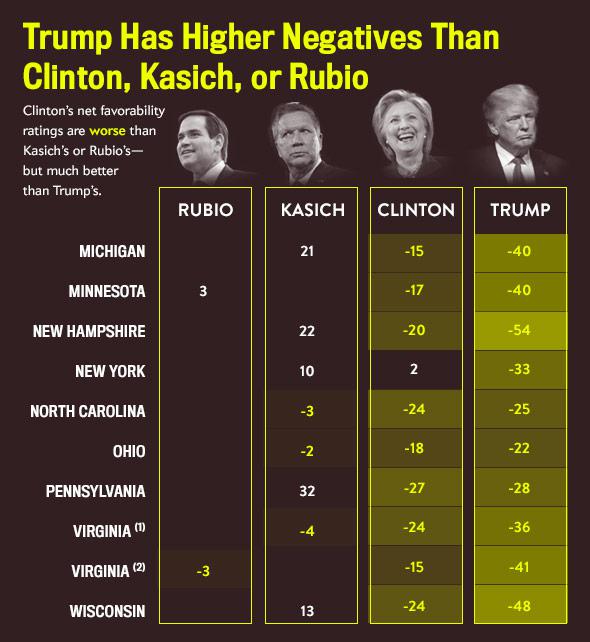Donald Trump has big plans for the general election. He’s going to bring millions of new voters into the Republican Party. He’s going to sweep the industrial Midwest. “I will win Michigan. … I will win Pennsylvania. … I will win Florida,” Trump predicted last week. “New York is in play,” too, he said. “I will win Upstate New York by massive numbers. I will win out on Long Island by massive numbers. … I will win sections of [New York] City that nobody else could win.”
Trump’s talk of broadening the electoral map, like everything else he says, is bluster. He’s the worst Republican presidential nominee in at least 50 years. His puerile, erratic, abrasive behavior has alienated millions of people. That’s not speculation; it’s a mathematical fact established by numerous polls. General-election polls at this stage in the cycle are far from dispositive, so I won’t call Trump toast. But surveys in key states show how unpopular he has become, and how badly he performs in comparison with previous and alternative Republican nominees.
To measure Trump’s predicament, I’ve put together the best available data in the battleground states. I started with 10 states that have voted for both parties in the past five elections: Arizona, Colorado, Florida, Iowa, Missouri, Nevada, New Hampshire, North Carolina, Ohio, and Virginia. I added two states that Trump says he’ll win (Michigan and Pennsylvania), two more that others say he could win (Minnesota and Wisconsin), one that he claims he could win (New York), and one that’s surprisingly close (Georgia).
In each of these 16 states, I looked for recent polls that asked people how they would vote in a hypothetical matchup between Trump and Hillary Clinton. I wanted polls that could be compared with similar surveys, ideally by the same pollster, at the same point in the 2012 election. I also looked for surveys in which Trump’s performance could be compared with two of his Republican competitors, Gov. John Kasich and Sen. Marco Rubio, in net favorability or in matchups with Clinton. The purpose of choosing these polls was to cancel out extraneous factors—sample, timing, survey methods—and clarify how bad Trump’s position is relative to Kasich, Rubio, and the GOP’s most recent presidential nominee, Mitt Romney.
In 13 of the 16 states—all but Colorado, Iowa, and Nevada—I found sufficiently recent and comparable surveys. In 10 states, the previous samples used for comparison were taken by the same pollsters four years earlier. By adding a few more polls to the analysis, we can compare, within the same samples, Trump’s performance with Kasich’s performance—or, in states where Kasich wasn’t tested, with Rubio’s performance.
The data expose Trump as a disaster. (You can find all the polling data I used here.) Let’s start with the four states he bragged about last week. Republicans have a good shot at Michigan, but not with Trump as their nominee. In an EPIC-MRA survey taken several weeks ago, Kasich beat Clinton in Michigan by 5 percentage points. In the same survey, Trump lost to Clinton by 11 points. In Pennsylvania, a Quinnipiac survey showed Kasich beating Clinton by 16 points. In the same sample, Trump lost to Clinton by 3 points. In Florida, Kasich wasn’t tested, but Rubio made the state a tossup against Clinton. Trump lost the state to Clinton by 8 points. In New York, where Kasich trailed Clinton by 10 points, Trump trailed her by 19.
Collectively, the data imply that with Kasich or Rubio at the top of the ticket, the GOP would beat Clinton in five states Romney lost: Michigan, Minnesota, New Hampshire, Pennsylvania, and Wisconsin. (See table below.) That’s 60 electoral votes. Add that to Romney’s 206, and you’re at 266. From there, any state puts you over the top. It could be Colorado, Iowa, or Nevada. It could be Florida. It could be Virginia, where a poll showed Clinton trailing Rubio by 3 percentage points, or Ohio, where another poll showed her losing to Kasich by 2. But the Republican nominee won’t be Kasich or Rubio. It’ll be Trump. And in the same surveys where Kasich or Rubio beats Clinton, Trump loses. He loses Florida, Michigan, Minnesota, New Hampshire, Ohio, Pennsylvania, Virginia, and Wisconsin—all the potential battleground states Romney lost.

Holly Allen and Natalie Matthews-Ramo
That doesn’t mean Trump will lose all these states on Election Day. From poll to poll, numbers vary. This week, for instance, Quinnipiac released new surveys that show Trump leading Clinton by 4 points in Ohio and trailing her by only a point in Florida and Pennsylvania. But those polls didn’t test Kasich or Rubio, so they don’t shed light on what we’re trying to capture here: discrepancies, within the same samples, between Trump’s performance and the performance of alternative candidates.
Trump also jeopardizes some Romney states. Romney won four of the 13 states on the list: Arizona, Georgia, Missouri, and North Carolina. Polls suggest that with Kasich or Rubio atop the ticket, the GOP would easily keep at least three of those states. (Georgia is unclear, since its most recent survey tested only Trump against Clinton.) In the same polls, Trump is shaky. He loses Arizona, puts Missouri in play, and turns North Carolina and Georgia into tossups. That’s 42 electoral votes, potentially dropping him to 164.
A lot can change between now and November. We don’t know how the numbers in each state will move, but we can use Romney as a model. Let’s suppose that in each state, from the most recent poll to Election Day, Trump’s performance relative to Clinton changes as much as Romney’s performance did relative to Barack Obama during the same period in 2012. That’s a generous assumption, given Trump’s high negative ratings (see below), but let’s give him the benefit of the doubt. In that case, Trump would win Arizona and Missouri, but he would lose Georgia. (See table below.) North Carolina, Ohio, and Pennsylvania would be very close. But even if Trump won all three, he’d be stuck at 228 electoral votes.

Holly Allen and Natalie Matthews-Ramo
If we apply the same rule of thumb to alternative nominees—measuring how Obama and Romney performed in each state, compared with their poll numbers at this point, and applying the same increase or decrease to this year’s Democratic and Republican candidates—Kasich and Rubio do much better than Trump. In that scenario, the GOP would win Arizona, Missouri, Minnesota, New Hampshire, North Carolina, Ohio, Pennsylvania, Wisconsin, and probably Georgia, for a total of 268 electoral votes. Michigan would be a tossup. Florida would be within 2 percentage points of flipping to the GOP. Virginia would be within 3 points. Any of those three states would put Republicans over the top. If none of them came through, Colorado, Iowa, or Nevada would do the trick.
Why does Trump, as a general-election candidate, fare worse than the Republican rivals he vanquished? Because while most Republican voters like him, most Americans don’t. Trump calls Romney a choker for losing in 2012. But this year, voters are choking on Trump. In each of the 10 battleground states where comparable polls are available, Trump’s net favorable rating—the percentage of voters who view him favorably, minus the percentage who view him unfavorably—is worse than Romney’s was at the same point in 2012. (See table below.) On average, the difference is 24 percentage points. That’s a brutal handicap.

Designed by Natalie Matthews-Ramo. Photos by AFP PHOTO/EMMANUEL DUNAND and John Sommers II/Getty Images.
Trump is so repellent that he’s losing to Clinton, a candidate with severe image problems of her own. On average, in the 10 states with comparable polls, Clinton’s net favorable rating is almost as far below Obama’s (at the same point in his 2012 campaign) as Trump’s is below Romney’s. A decent Republican could beat her. In the eight states where Kasich’s favorability was tested against Clinton’s, his net rating exceeded hers by an average of 27 percentage points. (See table below.) In a ninth state, Minnesota, Kasich wasn’t tested against Clinton, but Rubio—another guy Trump likes to ridicule as a choker—was. Rubio’s net favorable rating was 20 points higher than Clinton’s.

Designed by Natalie Matthews-Ramo. Photos by EMMANUEL DUNAND/AFP/Getty Images, John Sommers II/Getty Images, Bryan Thomas/Getty Images and JOSH EDELSON/AFP/Getty Images.
That’s a significant advantage for Republicans. Only a choker could squander it, and Trump is doing just that. On average, in the key states, his net favorable rating trails Clinton’s by 17 percentage points. Her net ratings are bad, ranging from +2 in New York to -28 in Ohio. Trump’s ratings, however, are atrocious, ranging from -16 in Pennsylvania to -54 in New Hampshire. He’s a gift to the Democratic Party.
You could argue that polls overrate Kasich and Rubio because their dirty laundry, unlike Trump’s, hasn’t been aired. That’s true of Sen. Bernie Sanders: His performance as the hypothetical Democratic nominee in general-election polls is inflated, because Clinton hasn’t hammered, or even addressed, all the nasty things about Sanders that Republicans would bring up in the fall. But Trump has unloaded freely on Kasich and Rubio. In debates, ads, and primaries, he told us all about Rubio’s credit cards and Kasich’s work at Lehman Brothers. Trump’s problem isn’t that voters know more about him than they do about Rubio or Kasich. His problem is that he’s Trump.
Some polls expose Trump’s wretchedness in greater detail. In 2012, Romney’s favorable ratings in New Hampshire were poor among independents, Democrats, union households, and people with little education. This year, in a survey by the same pollster at the same point in the race, Trump’s ratings in these demographic groups are worse—by 24 points among independents, 29 points among Democrats, 23 points among union households, and 19 points among people with a high school education or less. In Michigan, 40 percent of voters say their view of Clinton is very unfavorable. Only 10 percent express such antipathy toward Kasich, but 51 percent express it toward Trump. In Wisconsin, 42 percent of voters say they’re very uncomfortable with the prospect of Clinton as president. For Kasich, the number is 12 percent. For Trump, it’s 56 percent. In Florida, Ohio, and Pennsylvania, voters rate Trump below Clinton in presidential temperament, intelligence, moral standards, and caring about “people like you.”
These polls don’t prove Trump will lose. But they do provide a set of controlled experiments. They test his performance and the performance of other candidates in common samples, by identical methods, or at similar times in the campaign cycle. In this way, they quantify the damage he’s doing to his party. By nominating Trump instead of Kasich or Rubio, Republicans have sacrificed more than 40 percentage points in net favorability. They’ve jeopardized a dozen states and more than 150 electoral votes. If they lose, Trump will do what he always does: blame everyone else. But his defeat—like his tower, his casinos, and all those diplomas handed out by his scam university—will bear his name.
Welcome to the general election, Donald. The choke’s on you.
Read more Slate coverage of the 2016 campaign.
